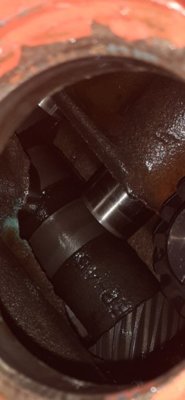Jimmy Jakobsson
Well-Known Member
Hi! I have built a Mopar 440 to 493cui stroker, Mahle 4340 flatop forged pistons with file fit rings, Compcam xe275hl( 231/237@050 and .525 lift both int/ext), Edelbrock e-street 84cc heads, Edelbrock rpm intake, Edelbrock 800 cfm avs2. Its running great and have a huge low end, no detonation at 93 octane and ignition timing curve 16 degrees initial, 34 full advance at 3200 rpm. Now, im a bit confused over the truth deck height, i have thinking a bit after wards and looking at pictures from the building and so on, the deck height on a Mopar 440 block from all years(my from -77) should have a deck height of 10,725" right? I have a eagle crank 4,150" stroke lenght, eagle H-beam rods 6,760" and this Mahle flat top pistons with a compression height of 1,865". When you counting of compression height(half stroke 2,075"+rod lenght cc 6,760"=8,835" and take that from deck height 10,725"-8,835"=1,89") i shold have a piston with compression height 1,89" to reach zero deck, my piston has 1,865" and i should than have 0,025" left to zero deck right. I have more like 0,043" to zero deck as you can see in the picture i share you almost can see the whole chamfer in top of the bore with piston at TDC. I use Fel pro head gasket with .039" compressed thicknes that gives about 9,48cc, pistons valve relifes 8cc, heads 84cc that should theoreticly give me a compression ratio 10,33:1 and a dynamic at about 8,05:1, but with the real measurement and the piston down 0,043" in the hole i get more like 9,97:1 and a dynamic at 8,02:1, the chamfer on top of the bore probably give a few cc combustion chamber more. Do the 440 block really vary this much? The measurement dont lie so probably. What do you say?


















